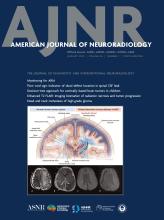This article requires a subscription to view the full text. If you have a subscription you may use the login form below to view the article. Access to this article can also be purchased.
Abstract
BACKGROUND AND PURPOSE: Idiopathic normal pressure hydrocephalus (iNPH) is reversible dementia that is underdiagnosed. The purpose of this study was to develop an automated diagnostic method for iNPH using artificial intelligence techniques with a T1-weighted MRI scan.
MATERIALS AND METHODS: We quantified iNPH, Parkinson disease, Alzheimer disease, and healthy controls on T1-weighted 3D brain MRI scans using 452 scans for training and 110 scans for testing. Automatic component measurement algorithms were developed for the Evans index, Sylvian fissure enlargement, high-convexity tightness, callosal angle, and normalized lateral ventricle volume. XGBoost models were trained for both automated measurements and manual labels for iNPH prediction.
RESULTS: A total of 452 patients (200 men; mean age, 73.2 [SD, 6.5] years) were included in the training set. Of the 452 patients, 111 (24.6%) had iNPH. We obtained area under the curve (AUC) values of 0.956 for automatically measured high-convexity tightness and 0.830 for Sylvian fissure enlargement. Intraclass correlation values of 0.824 for the callosal angle and 0.924 for the Evans index were measured. By means of the decision tree of the XGBoost model, the model trained on manual labels obtained an average cross-validation AUC of 0.988 on the training set and 0.938 on the unseen test set, while the fully automated model obtained a cross-validation AUC of 0.983 and an unseen test AUC of 0.936.
CONCLUSIONS: We demonstrated a machine learning algorithm capable of diagnosing iNPH from a 3D T1-weighted MRI that is robust to the failure. We propose a method to scan large numbers of 3D T1-weighted MRIs with minimal human intervention, making possible large-scale iNPH screening.
ABBREVIATIONS:
- AD
- Alzheimer disease
- AUC
- area under the curve
- DESH
- disproportionately enlarged subarachnoid space hydrocephalus
- HC
- healthy controls
- ICV
- intracranial volume
- iNPH
- idiopathic normal-pressure hydrocephalus
- PD
- Parkinson disease
- ROC
- receiver operating characteristic
- SENSE
- sensitivity encoding
- © 2025 by American Journal of Neuroradiology












